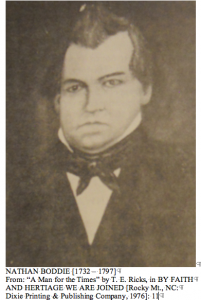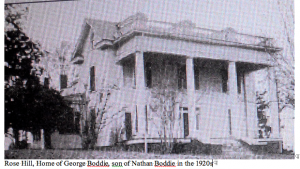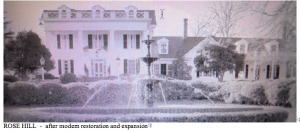Over the long sweep of time since the establishment of Nash County, in December of 1777, few men have matched Nathan Boddie’s constructive contributions to the development and progress of the county. Before the creation, he lived with his wife Chloe Crudup and their family on Peachtree Creek in western Edgecombe County. They were located in an area that would be in Nash County after 1777. By the time of his political prominence their Rose Hill plantation consisted of some nine thousand four hundred acres, a substantial slave population and Boddie’s Mill.
He was born on the 22 February 1732 at Etherton Cross Roads in Isle of Wight County, Virginia. At two years old his family moved to North Carolina. His original home does not stand, however, the one he built for his son George Boddie, in 1792, survived to the modern period and is the back wing of the present, restored Rose Hill Plantation.
In the 1770s, as the population of western Edgecombe County grew, men living in that part of the county, led by Nathan Boddie, sought to divide Edgecombe into two counties. The petition for this division, dated 17 November 1777, contains some two hundred fifty four signatures. A close reading of it reveals that several men signed it more than once, scattering their names about, probably to enhance the appearance of extensive popular support for the division among those citizens who lived in the western part of the county. In 1777, the bill put before the North Carolina General Assembly was heavily the work of Nathan Boddie and he introduced it under his authority as a representative of Edgecombe County. By 4 December 1777 the final bill appeared before the Assembly, with amendments. One of the most important amendments in the final bill changed the dividing line between the two counties from “the mouth of Stony Creek”, the wording of the original bill, to the “Falls of the Tar River,” the specification of the final bill.
On 22 December 1777, the North Carolina State Records Book on page 435 records the directions to the early founders of Nash County by the North Carolina House, with the concurrence of the Senate, to form a separate county by mandating and establishing the procedures for qualifying, nominating and appointing Justices of the Peace, a Sheriff to hold elections, preserve the peace and execute process; and the building a temporary courthouse instructed to hold court in April, 1778. The Justices were directed to meet in the home of Micajah Thomas, who later served briefly as sheriff. In 1976, his home is identified as standing, in the 1770s, “in the block in which the Nashville Fire Department now stands.” In 1778, the temporary court house was built and used until the construction of a more permanent one in 1784. Duncan Lamon, Nathan Boddie, Matthew Drake, Edward Clinch and Arthur Arrington, Nash County’s first sheriff, were given the responsibility of contracting with workmen to build the court house. As the outset, the county seat for Nash County was Nash Court House which lasted until the incorporation of the town of Nashville in 1790.
Nathan Boddie is selected as the Person of the Month because of his contributions to: [1] the creation and establishment of Nash County; [2] winning independence in 1776 by serving as a representative in the North Carolina Provincial Congress that met in Halifax and selected delegates to the Continental Congress in Philadelphia; [3] the interests of Nash County while serving as a representative of Edgecombe County in the North Carolina General Assembly; [4] the building of the first Nash County Court House; [5] the administration of justice in the county as a Justice of the Peace; and [6] protecting the interests of Nash County as a state senator in the North Carolina House of Commons from 1778 to 1781. He died on 7 December 1797 leaving a family tradition of public service to Nash County and North Carolina that would by shouldered by many subsequent generations of Boddies and their kin.
SOURCES: among the sources for the above information much of came from articles written for: BY FAITH AND HERITAGE ARE WE JOINED: A COMPILATION OF NASH COUNTY HISTORICAL NOTES, edited by T. E. Ricks, [Rocky Mt., NC: Dixie Printing & Publishing Company, 1976]. In this Bicentennial tribute to Nash County, NC, compiled and published by The Nash County Bicentennial Commission the most useful two essays were:
1. Joseph W. Watson, “Nash County was born 198 Years Ago,” pages 8 and 9.
2. T. E. Ricks, “A Man for the Times,” page 11.


